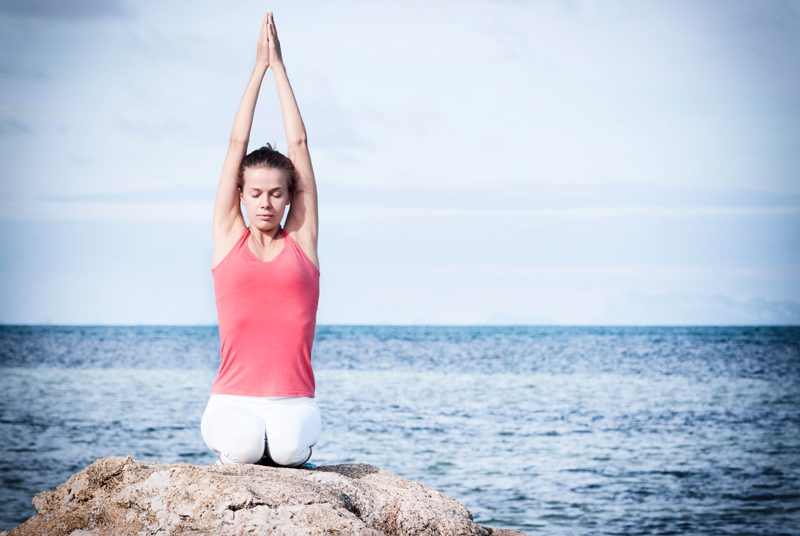
What is the Difference Between Yoga and Pilates?
July 11, 2019
How do I Start Meditating at Home?
July 25, 2019Kriya Yoga: What is it and What are its Benefits?

Kriya yoga is an ancient meditation technique that focuses on energy and breath control. Depending on your preference, the style can either be practiced using just pranayama or turned into more of a spiritual path. To achieve the latter, there’s more to it than just putting on your yoga bra; instead, pranayama is combined with meditation techniques and an all-round yogic lifestyle. In this article, we explore Kriya yoga in more detail.
History and Origins
Kriya yoga was first openly practiced in 1861 when Mahavatar Babaji taught the practice to his disciple, Lahiri Mahasaya. However, it’s believed that it was invented before this date, but was hidden in secrecy until it was brought to light by Mahavatar Babaji. From then on, the style was passed down the line from Lahiri Mahasaya to his disciple Sri Yukteswar, who later taught it to his own disciple, Paramhansa Yogananda. A few years later, Yogananda published a book called ‘Autobiography of a Yogi’ which contained the teachings of the ancient practice. It was this publication that popularized Kriya all over the world.
How Does it Work?
Traditionally, Kriya yoga is used to achieve union with the Divine. According to Paramhansa Yogananda, the style is the easiest and most effective way to reach this goal as it focusses on our spiritual energy. While all yoga styles work indirectly with energy, Kriya is the only technique that directly awakens the energy in the spine. Through Kriya, we can control our life energy, or prana, by mentally drawing it up and down the spine. When done correctly, this can improve our awareness and self-will. In Yogananda’s book, he suggests that practicing Kriya for just 30 seconds is equivalent to a whole year of natural spiritual growth.
How to Practice it
Kriya yoga can be taught by any certified instructor. In most cases, these instructors will have been certified by Swami Kriyananda, a yoga guru who learned the technique from Yogananda himself. To be classed as experienced, instructors need a minimum of 20 years’ experience under their belt. As Kriya is fairly complicated, it’s best to learn the style from someone who really knows their stuff! Unfortunately, good quality Kriya classes can be hard to come by. While there are certified studios in India, Italy, and the UK, classes in the US are far less common. However, a good-quality class can be found if you’re willing to travel.
Before getting started with Kriya, you’ll need to undergo a preparation process. This includes research of Paramhansa Yogananda’s teachings and various meditation styles. On average, the preparation process takes one year to complete; however, the exact timeframe will depend on the individual. The way the preparation process is carried out will also vary between studios. Some instructors prefer students to attend a center and learn directly, while others are happy for students to self-teach through books and online classes. Once the preparation process is complete, you’ll be welcomed into the Kriya community and begin to learn the full technique.

Benefits
Like all types of yoga, Kriya boasts a range of great benefits. While some of these can only be achieved through long-term practice, others can be seen immediately. One of the best immediate benefits is the skill of changing negative emotions into positive ones. This is achieved through various pranayama techniques that work to adapt thought patterns. It is also believed that Kriya can improve concentration. When using the style, practitioners learn to create a calm environment in which thoughts can come and go freely. By doing this, students are able to assess where each thought is coming from and decide whether or not it’s significant.
Many people regard Kriya as the most spiritual practice of all time. When using the style, it is thought that the physical body becomes one with the soul. Many yogis believe that this process helps to evolve the spiritual mind. Working to create a space of tranquility and awareness, Kriya teaches us to become more compassionate and understanding of others. Additionally, the style reminds us to be kind to ourselves as we are only human. Many students report that this realization encourages them to assist others but to also take time for themselves when needed.
Kriya is also used to cleanse and unblock the chakras. When done correctly, this process offers a range of mental and physical health benefits. If you’re experiencing tiredness, fatigue, and lack of focus, there may well be an energetic blockage in your body. Through Kriya, you can unblock this by awakening the energy at the base of your spine. This spiritual energy is referred to as ‘Kundalini’. Cleansing the chakras can have a number of other benefits, too. Some of these include increased focus, improved energy levels, and better blood flow.
In Summary
Whether you’re hoping to reap the health benefits of Kriya or you’re more interested in finding inner peace, practice the style regularly to achieve your goal. Unlike other yoga styles, Kriya is difficult to self-teach. With this in mind, we recommend finding a Kriya class instead of teaching yourself at home. If worse comes to worst, you can begin learning the technique with books and online classes. When you feel confident with the preparation process, you can then look for an experienced instructor to learn the rest of the technique. While you may have to travel for this, it will certainly be worth it in the end! Before your first Kriya session, ask your instructor what you’ll need to bring. In most cases, a yoga bag packed with comfortable clothing and a water bottle will be sufficient. This will ensure you’re comfortable throughout the session and that you don’t become dehydrated.

